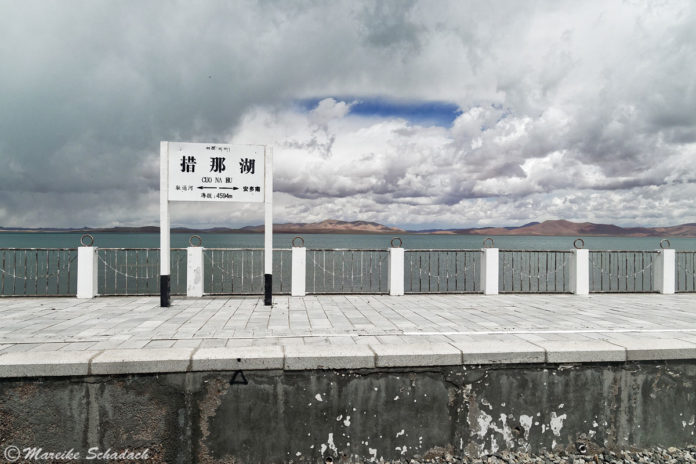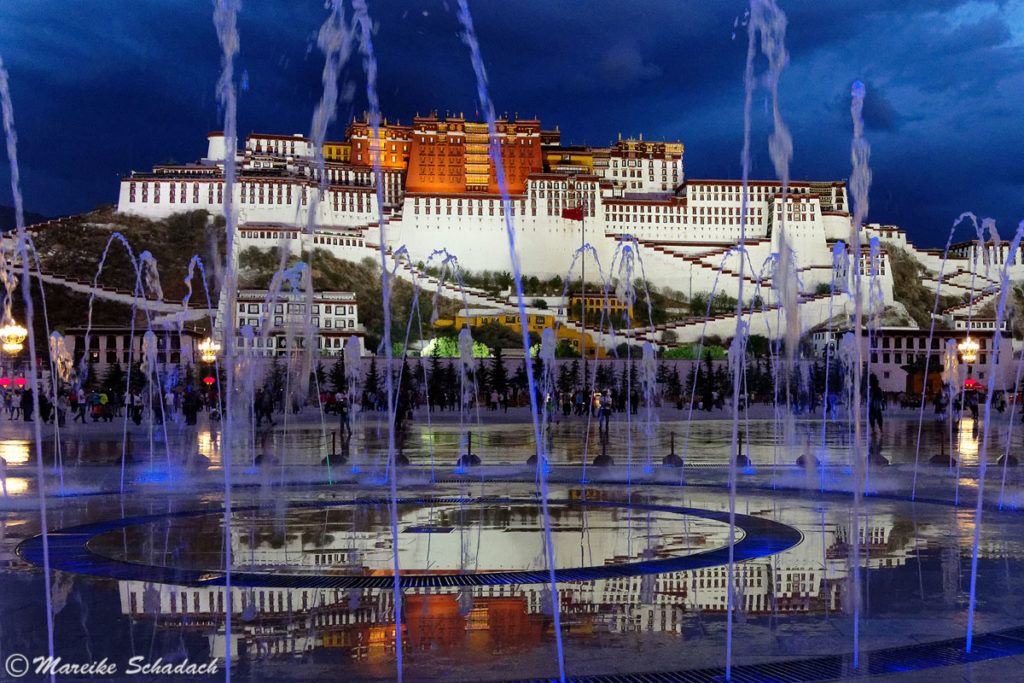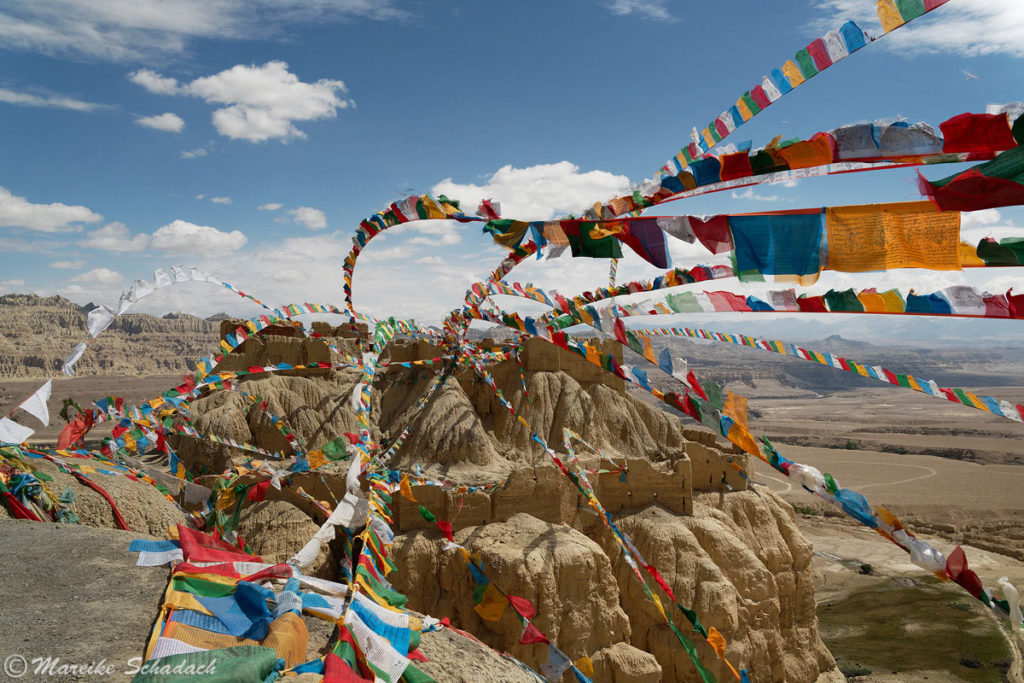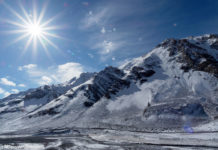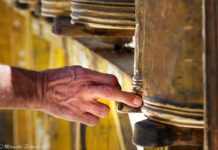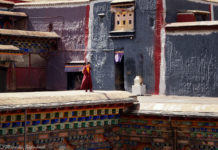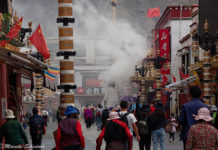China – Tibet. Taking the train to Lhasa is both an adventure and a lot of fun. If you want to experience the Chinese and Tibetan culture intensively, can do without private sphere and a shower for some time, I can warmly recommend you a train ride with the Lhasa railway to the roof of the world. The route is simply breathtaking. And not only because of the average height of 4.000 m. The vastness of the landscape brings your mind to rest, while snow-capped peaks, rivers and lakes regularly crowd the windows. In my following article you will learn all my tips for your trip with the Lhasa Railway to Tibet.
Non-solicited, unpaid advertising. This article contains affiliate links*, marked with an asterisk.
Table of Contents and Quick Navigation
To get in the Mood for the Train Journey to Tibet
Slow Travel - a great Way to Travel
The Route of the Lhasa Railway to the Roof of the World
From Xining to Lhasa - A few Pictures
Ticket Classes and Prices of the Lhasa Railway
Tips for your Ticket Purchase for the Lhasa Railway
Pick-up of Tickets at the Train Station
Tips for the Organization of Luggage in the Lhasa Railway
Orientation at Xining Station
How to find your Carriage and your Bed
Where to put the Luggage?
Equipment in the Hard Sleeper Class
Altitude Sickness
The physical Well-Being
Tips for the Packing List for the Lhasa Railway
Arrival in Lhasa
To get in the Mood for the Train Journey to Tibet
My earpax is penetrated by a pimped rumble. I feel the vibration of the wheels and the unevenness of the tracks. From the corridor light shines into our dark cabin. I roll to my other side, carefully not to fall out of the narrow top bed. A glance at the altimeter lets me breathe a sigh of relief. After four hours driving time, it is 23:30 we are again under 3,000 m. Finally I fall asleep.
When I wake up in the morning we are at 4.200 m. I look into a hilly landscape covered with icing sugar. On the horizon there are higher mountains with snow-covered peaks. From time to time I can spot wild donkeys, Tibetan antelopes or yaks, sometimes also a nomad hut. Again and again there are small houses of track marshals along the parallel road and now and then we pass a settlement. I am looking forward to the day in the train that lies ahead of me.

Slow Travel - a great Way to Travel
Travelling by train produces less carbon dioxide than travelling by plane. That alone is reason enough to travel more often by train. But there are even more advantages over travelling by plane. Because one approaches a new country or a new culture more slowly and has more time to perceive the changes more consciously.
With Slow Travel, I feel less foreign and more connected to my destination and the people who live there. So somehow more like a traveller than someone who just consumes. In addition, a train journey like this trains one's own travel skills, self-confidence and openness. And a long-distance train ride always has the potential for great travel stories.
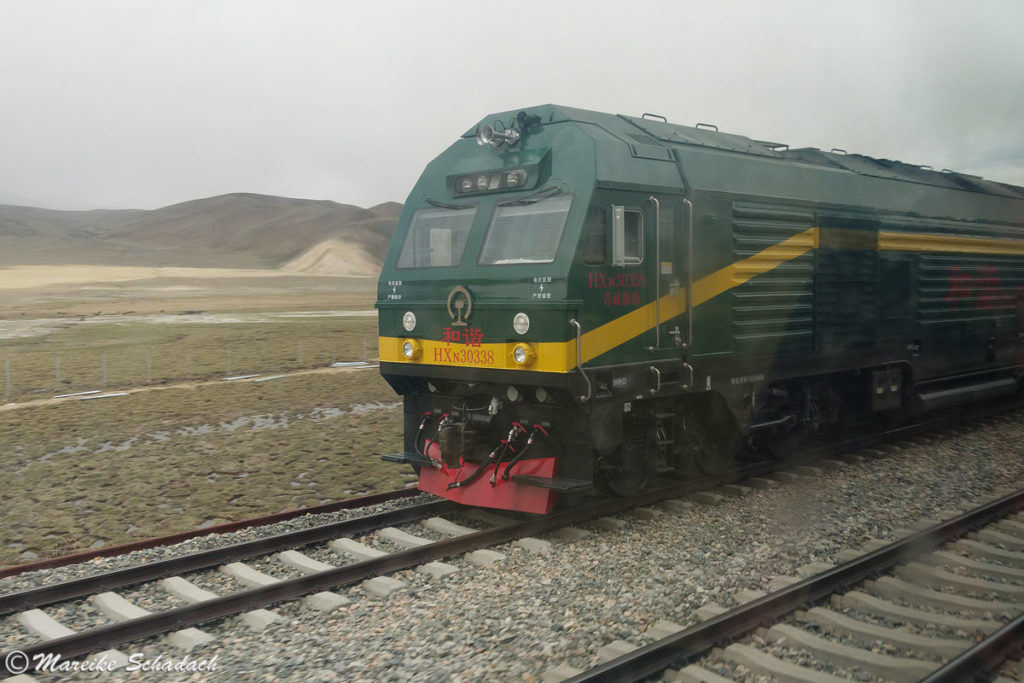
The Route of the Lhasa Railway to the Roof of the World
There are several railway lines that go to Lhasa. However, most travellers take the train from Xining in Qinghai Province to Lhasa. This is the shortest train journey to Tibet with only one night on the train. The route also has the most beautiful landscapes to offer. The train even runs five times a day and takes about 21 hours to cover the distance of 1,956 km. If you want to travel longer by train, you can choose the longer route from Beijing to Lhasa . However, here the train only travels once a day and it is therefore more difficult to get a ticket.
We chose Xining as the departure station because we were more flexible in our choice of departure time. Because if you leave Xining in the evening, then you will drive through the most beautiful landscape in daylight. If you start from Beijing, you have no choice in this respect and the most beautiful landscape you will experience only in the dark.
Xining also has a lot to offer. And if you spend a few days in Xining at an altitude of 2,200 m and maybe go on a day trip to Qinghai Lake at 3,200 m, you'll already have quite a good altitude adjustment.
From Xining to Lhasa - A few Pictures
The drive takes us past Cona Lake in the afternoon. This is a holy lake for the Tibetans and also one of the highest freshwater reservoirs. On the shore of the lake black-necked cranes fly up, geese and ducks look for food in the water, seagulls fly just above the water or clean their plumage on the shore.
Along the way there are countless small police stations. Each of them carries a Chinese flag. As soon as we drive past, the police stations come out in their yellow warning vests and salute.

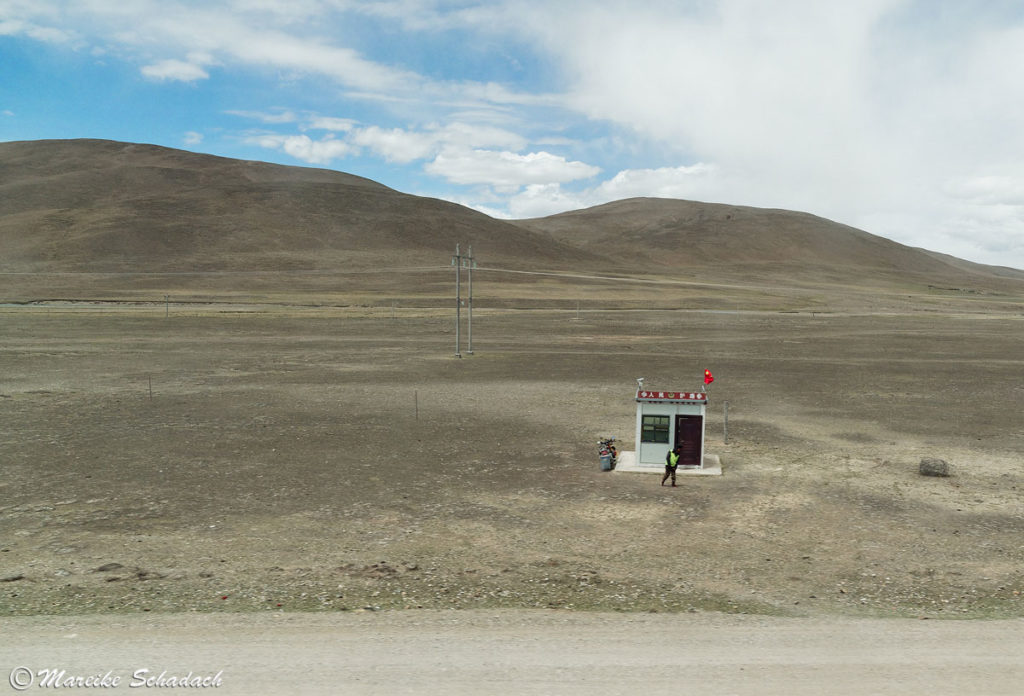
We pass small settlements. Small one-storey stone houses, white, the roof decorated with colourful prayer flags. Around the houses there is a walled courtyard, next to it there is a second courtyard with shelters for the cattle. The paths are unpaved, at the roadsides there are mopeds and older cars. Around noon we see more and more yaks and sheep on the grazing grounds next to the railway line. It is lunchtime, almost everyone touches his instant noodles in the colorful plastic packaging. In the wagon there is a pleasurable smacking and burping from all directions.
Ticket Classes and Prices of the Lhasa Railway
There are three different classes in the Lhasa Railway. The following prices apply to a single ticket from Xining to Lhasa in the summer season.
- The Soft Sleeper class (1st class) with 4 beds per cabin. Here it is more comfortable than in the Hard Sleeper class, there are doors for more privacy and tranquility. Tickets are available for about 105 Euro.
- The Hard Sleeper class (2nd class) is much cheaper at 67 Euros. Each cabin has 6 beds. Since many locals travel in the Hard Sleeper cabins, you are less touristy.
- With a price of 29 Euros, the Hard Seats are the cheapest way to travel to Lhasa, but with zero comfort.
Tips for your Ticket Purchase for the Lhasa Railway
Even the purchase of a ticket for the Lhasa Railway was a small adventure in itself. The ticket purchase demanded flexibility, quick rethinking and action from us. And before we knew it, we had our first change in the itinerary even before the trip started.
It is a bit different than in Germany. You can reserve your desired tickets 60 days before the scheduled departure date at trip.com .But you can't buy them yet. About four weeks before the trip you will be notified by trip.com if your reservation was successful and the tickets will be issued. If you're lucky, you'll get the tickets. If not, you will now have the opportunity to choose another train or class. And now you have to be fast, because the denn die trains are fully booked in no time. You can literally watch it happen.
The booking system randomly allocates the beds. It tries to occupy neighbouring beds, but unfortunately you can't influence anything. Likewise, you have no influence on whether you get a lower, middle or upper bed. If you are more than one person, it can also happen that your beds are in different wagons when you book. If you are not satisfied with the number of beds allocated, try your luck with another booking and then cancel the first one.
We had no luck with our reservation and did not get our desired tickets in the Soft Sleeper class. Only the third booking made us proud owners of two tickets for adjacent beds in the Hard Sleeper class, but on the train two days later. We were quite happy that our itinerary had so much room for rescheduling.
Finally time to read again! Here I have a few tips for suitable travel reading* for you. Maybe you also want to listen to an audiobook in the Audible trial subscription*? Then you can listen while your eyes wander over the vast plateau of Tibet.
Pick-up of Tickets at the Train Station
But buying online is not enough. You must pick up your ticket at the station upon presentation of your passport, the pick-up number on your order at Trip.com and the Tibet Travel Permit. The Tibet Travel Permit is your ticket, so to speak. Nothing works without it. However, it can only be applied for by a local travel agency. We received it by e-mail only two days before the departure of the train, normally about seven to ten days before. In summer 2019 we should take six copies of the travel permit with us. We didn't have to hand in any of them, but we had to show them countless times.
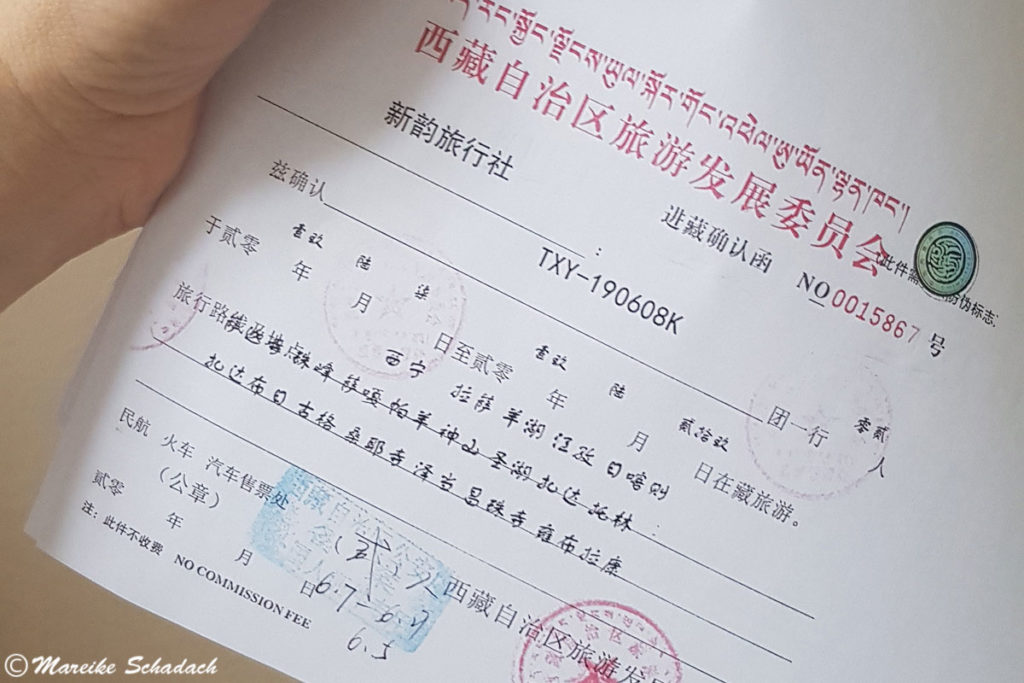
In Xining, the ticket collection point is located on the upper platform of the station, to the left of the main entrance. The entrance to the train station is only possible after presentation of a valid ticket. In the basement, below the station forecourt, there are several shops where you can buy provisions for the journey.
Tips for the Organization of Luggage in the Lhasa Railway
It is best to pack your luggage in several bags: Valuables in an extra bag, which you always carry with you, then a bag with the things you need on the train journey and have to open more often, as well as provisions. This will also reduce the risk of your large baggage appearing too large and having to be checked in. Our luggage was not weighed or remeasured. You are allowed 20 kg per person and the maximum overall dimensions are 160 cm. If you have more luggage, you must check it in. You should be at the station about two hours before departure. Your luggage will then be transported in the same train in the baggage carriage.
Orientation at Xining Station
Once you've passed through the security check at the main entrance, the next step is to find the right track . A large display shows all departures. The destinations are in Chinese only. But you can then assign the right track based on the departure times.
There is a huge waiting hall with enough seats, snacks, shops and a supermarket with a large selection of provisions and even filling stations for boiled water for your thermos flask.
For boarding you have to show your ticket, passport and travel permit.

How to find your Carriage and your Bed
You will find the number of the wagon and cabin on your booking confirmation and on your ticket. Here you can also see if you have the lower, middle or upper bed.
The number of the wagon is written on the ticket before the Chinese character 车, the number of the cabin before the character 号. You can tell which bed you have by the characters "上铺" for the upper bed, "中铺" for the middle bed, "下铺" for the lower bed.
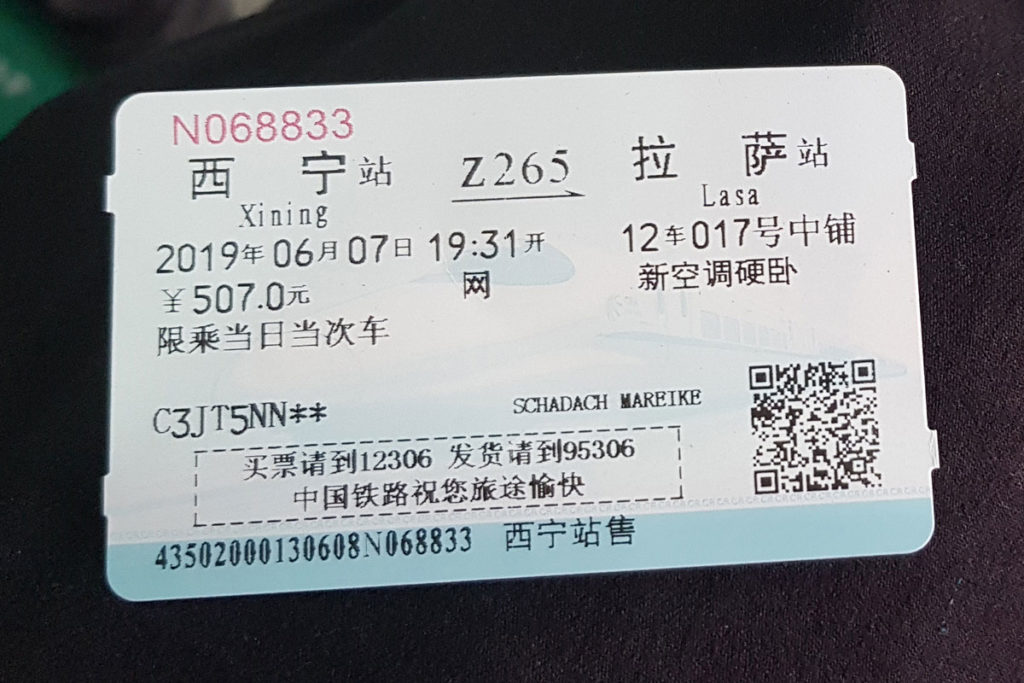
After boarding, the boarding personnel will distribute forms for completion. Everything was in Chinese and since nobody spoke English in our and the neighbouring cabins, we just looked helplessly at the characters. Later the wagon attendant brought us the forms of the "Passenger Health declaration" in English.
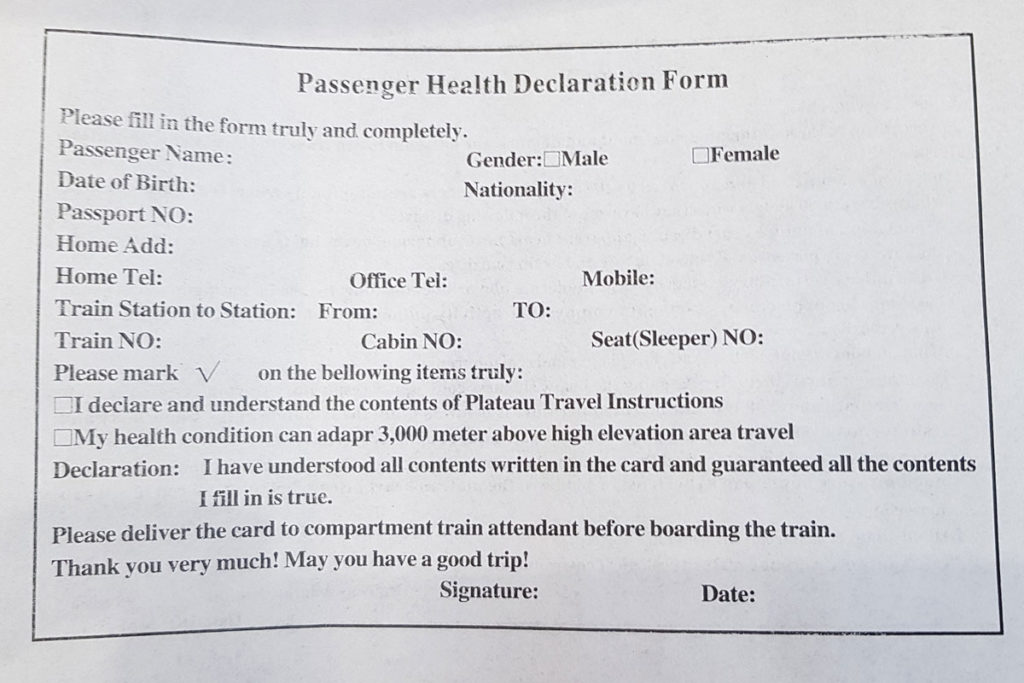

Where to put the Luggage?
In the Hard Sleeper class there are two ways to stow your luggage: Under the lower bed or on the luggage racks at the foot of the upper beds. You should always carry valuables with you. There is no lockable luggage storage. There is also a hook and a small net on each bed for storing smaller items.
Equipment in the Hard Sleeper Class
If you want to travel cheap and comfortable by train to Lhasa, the Hard Sleeper class is the right choice. The beds are not as hard as the name suggests. The name simply means that the mattress is thinner than the Soft Sleepers.
There are six beds in each cabin, three of which are arranged one above the other. The cabins are open towards the corridor, so there is no lockable door, no curtains and no privacy. Each bed is equipped with a mattress, blanket and pillow. The beds are with 60 cm x 180 cm slightly smaller than the Soft Sleepers but still as big as my sleeping mat. Only with the lower bed the distance to the ceiling is so high that you can sit comfortably on it and have a view through the window. I had the upper bed. It's not that easy to circle your way over the steps into the bed. Sitting is only possible with your head bent.

There is also a folding seat and a folding table per compartment in the corridor. Between the two lower beds there is a small table.
At 22 o'clock the light in the cabins is switched off, then it is night rest. Then only dimmed light from the hallway shines in.
Sockets or USB charging points can be found in the corridor, but only one per cabin. Remember to take an adapter with you, possibly also a multiple plug. It's best to recharge all batteries completely before entering the train. WiFi is not available on trains.
In the Hard Sleeper class there are two hock toilets built in. Usually there is no toilet paper left, so take enough with you. Also at the end of the wagons you will find three open wash basins. You have to bring your own towels and soap.
Altitude Sickness
The Lhasa Railway runs on about 90 % of the line at an altitude of 4,000 m. In Xining it starts at 2200 m and crosses two passes over 5,000 m on its way to Lhasa (Fenghuo Pass at 5,010 m and Tanggula Pass at 5,220 m). After about 21 hours you will arrive in Lahsa at 3.650 m.
A height adjustment is not possible in such a short time. In order to prevent altitude sickness, oxygen is fed into the wagons via the air conditioning system. Nevertheless, you may feel the altitude. The first signs are headaches and tiredness. It helps to rest, drink a lot and breathe deeply. I didn't have any difficulties with the altitude adjustment myself, but I had already spent three nights in Xining at 2,200 m before.

In addition there is an individual oxygen supply via a breathing tube at each bed, which has to be activated by the car attendant. From Golmund there are medical staff on the train who can be contacted if necessary.
Another effect of the height is the increase in UV radiation. The windows of the train are therefore all equipped with a UV filter. The dining car also has white curtains with a picture of the Lhasa train on a bridge.

The physical Well-Being
If it gets too cramped in the cabins, you don't have a window seat or you get hungry, you'll find the dining carriage in the middle of the train. Here you can sit and eat comfortably. Chinese and Tibetan dishes are offered, but the menu is only in Chinese. After a while there was a waitress who explained the menu to us with some English and took our order.
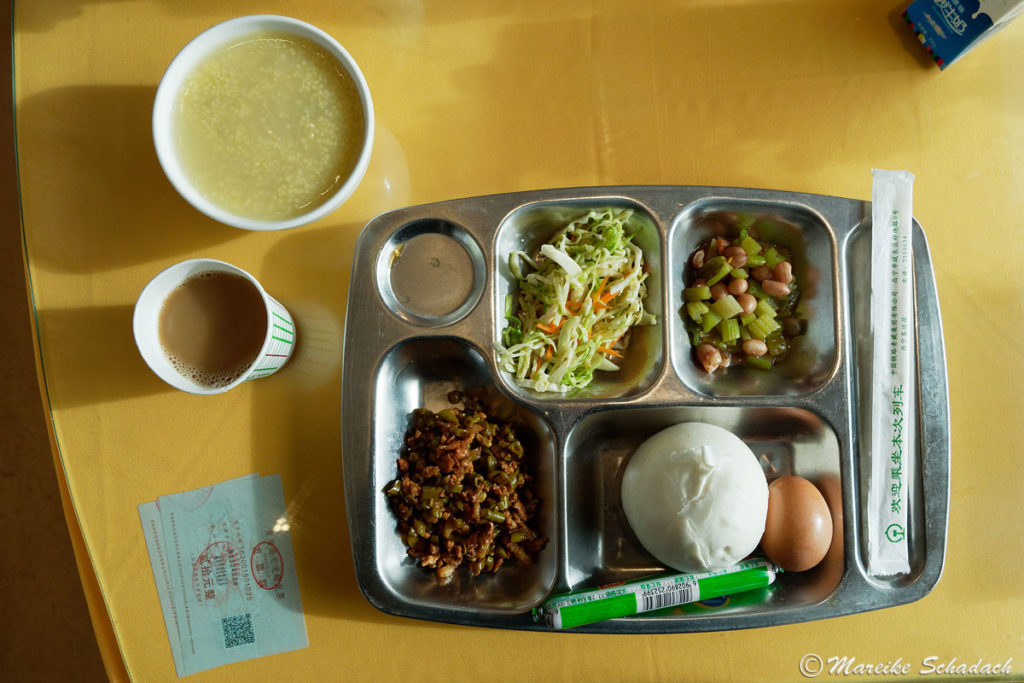


In addition to the dining car, you can buy snacks, fruit and drinks on mobile cars that are pushed through the sleeping cars. But keep in mind that you pay a higher price for everything on the train. It's best to bring your own food. Since hot water is available on the train, you can make your own coffee, tea or instant noodles on the train at any time. If you order coffee in the dining car, you'll only get instant coffee, usually ready mixed with milk and sugar. You'll find the water stations at the end of the wagons. Here you can also fill your thermos jug with hot water. And remember: drinking a lot helps to adjust the height.
Tips for the Packing List for the Lhasa Railway
Here are a few tips on what you should take with you on the Lhasa Railway:
- thermos flask
- sleep specs
- Ohropax made of wax (the foam rubber ones don't work so well in height)
- Toilet paper
- Soap and towel
- Warm sweater
- Charging cable for mobile phone, Powerbar if necessary
- Adapter for the socket outlet
- Music or audio books
- book
- camera
- Helpful apps: Bing Translator (offline), Altimeter, Maps.me
- water, tea bags, instant coffee, provisions if necessary
You can find the right travel backpack, mountain boots and everything else you might need on the road at Globetrotter*.

Arrival in Lhasa
At the end of the trip there was an announcement in English which made me smile again and again:
“…It’s now time to say good by, we cannot stop the time. We wish to stay with you forever. We wish you a good health and hope to see you next time…”
After the arrival of the Lhasa Railway on the roof of the world you have to go through a security check again. Passport holders will be taken to a separate building to the right of the exit. In our train there were about 13 people with passports. All other travellers were Chinese.
Welcome to Lhasa!
Book Recommendations for Tibet
You want to know where the journey goes? Then I can recommend these books* about Tibet.
You can order these books at Amazon with a click on the pictures. If you buy a product via one of these affiliate links, I get a small commission and you help me to keep filling Fernweh-Motive with interesting articles. The product will not be more expensive for you.
Have you ever ridden the Lhasa Railway yourself? How did you like it? Do you have any more questions about my article or any other tips for the ride on the Lhasabahn? If so, please write me a comment!
Do you want to know when there are new articles on my blog? Then follow me on Facebook, Pinterest or Instagram. I would also be very happy if you share my article with your friends.
